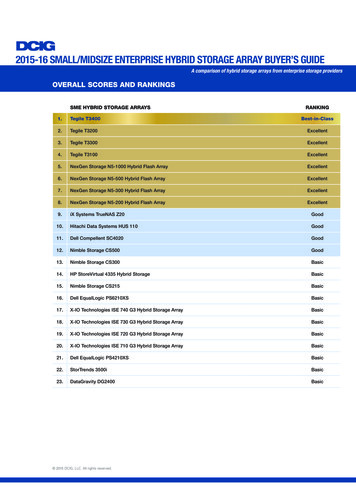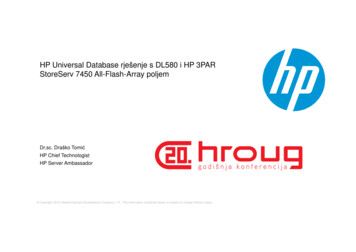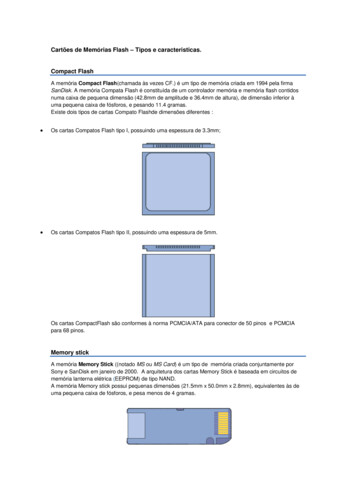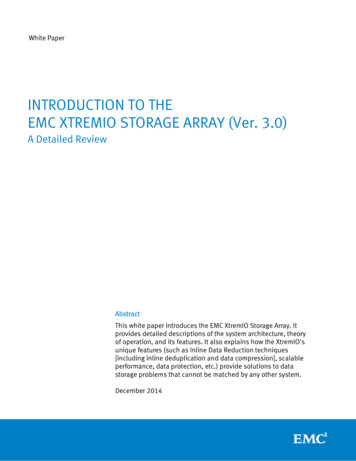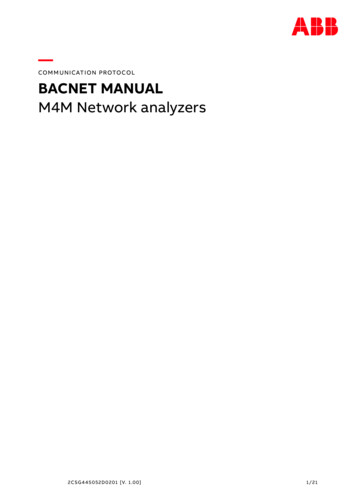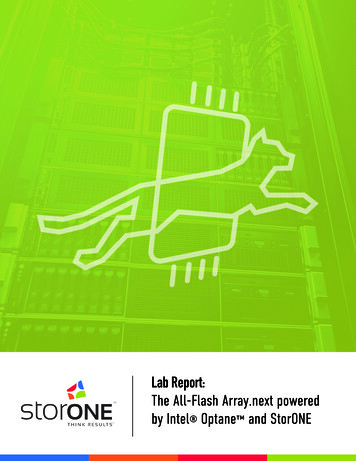
Transcription
Lab Report:The All-Flash Array.next poweredby Intel Optane and StorONE
The S1:AFA.next combines an Intelserver with the power and performanceof Intel Optane Drives with Intel QLCdrives. StorONE’s efficient EnterpriseStorage Platform powers the Intelhardware. The solution validatesStorONE’s claim of extracting 85%or more of the performance fromany drive technology.StorONE recently tested the S1:All-Flash Array.next (AFAn) in StorONE’s lab. The purpose ofthe tests was to validate StorONE’s claims of delivering optimal per drive performance while stillproviding enterprise-class storage services. The test proves that the AFAn delivers an affordableconfiguration of Intel Optane performance to enterprise customers. At the same time, theAFAn can provide all the enterprise features data centers expect. The AFAn is the next logicalupgrade to existing AFAs. It offers better performance and features at a lower price, enablingorganizations to scale-up application environments and significantly reduce softwarelicensing costs.WHAT MAKES StorONE S1:AFAn UNIQUE?StorONE S1:AFAn delivers over 1 million IOPS with only THREE Intel Optane Drives. Performance continues to scale as more Intel Optane SSD Drives are addedto the system.StorONE S1:AFAn uses Intel Optane as Storage not as a Cache. Intel Optane tier is protected from media failure. All writes from applications go exclusively to Intel Optane storage. Takes full advantage of the unique high performance write potentialof Intel Optane .StorONE S1:AFAn delivers QLC Aware Tiering. Using Intel Optane as storage alsoenables data to “settle” prior to being written to QLC. The write to QLC is sequential,and the likelihood of change is low. QLC read performance, thanks to sequential writes,is similar to Intel Optane , so data is read in-place, further preserving QLC durability.WHO IS StorONE?StorONE is the developer of S1, the first Enterprise Storage Platform. An enterprise storageplatform is a hardware-independent software solution that consolidates all storage use cases(file, block, object, cloud) into a single operating environment. Unlike legacy storage softwarewritten over a decade ago, S1 delivers 85% of the maximum manufactures specification for theperformance of the storage hardware. The Platform also provides the complete set of storageservices that enterprise data centers demand, such as protection from media failure, accidental ormalicious data deletion, and data center-wide disaster.
THE PURPOSE OF AFAnData Centers of all sizes face constant pressure to deliver an architecture that can meet theever-increasing expectation of high-performance. Intel Optane Storage Class Memory isan ideal answer to these demands. Public Cloud Providers, Hyperscalers, and organizationswith considerable artificial intelligence and deep learning workloads are integrating Intel Optane into their environments because the performance gains lead to better decisionsthat directly impact the organization’s bottom line.Intel Optane has struggled to find its place in mainstream data centers because thesefacilities need to balance the gains in performance with the overall cost. To justify theinvestment in Intel Optane , organizations must leverage Intel Optane across as manyworkloads as possible and reduce the investment in other parts of the infrastructure. QLCflash is an ideal technology to partner with Intel Optane because it delivers affordablecapacity and excellent read performance.The challenge is QLC’s low write durability. If Intel Optane is used as storage and not as acache, it can act as a shock absorber so that QLC’s low endurance does not impact the datacenter’s access to data. Most implementations of Intel Optane have been as aread-only cache, which eliminates a critical technological differentiator for Intel Optane ,write performance.Using Intel Optane as storage is a more logical use case, but it must be combined withQLC to make the combined solution an affordable cost. IT, though, can’t afford, yet anotherprocess to manage. As a result, the movement of data between these two tiers must beseamless via automated tiering technology. Once implemented, IT architects can realizehigher performance and even higher cost savings by using a large tier of QLC and a small tierof Intel Optane versus the cost of a TLC-only all-flash array.The net impact of the S1:AFAn is a storage system capable of millions of IOPS and verylow latency, while significantly less expensive than AFAs. By implementing S1:AFAn, thedata center can reduce the licensing cost of applications like Oracle, MS-SQL, and VMwarebecause each physical system is better utilized. Given the per-core cost of some of thesesoftware applications, the reduction in licensing fees alone may pay for an OFA investment.UNDERSTANDING THE STORAGE SYSTEM ECO-SYSTEMA Storage System is a combination of several parts, storage media, storage network, CPUs,and storage software. Extracting maximum performance out of the storage eco-systemmeans removing as many bottlenecks as possible. Before enterprise solid-state drives (SSD)based on flash, storage media was always the most significant source of IO bottlenecks.Flash and now especially, Intel Optane , moves that focus elsewhere. The internal networkand the protocol the storage system uses to communicate with the media is no longer asource of the bottleneck thanks to NVMe, which offers PCIe access, higher command count,and higher queue depth. Even the storage network is no longer the primary bottleneck,thanks to the latest high-bandwidth advances in Ethernet and Fibre-Channel, as well as thepotential of NVMe over Fabrics (NVMe-oF).
There has always been enough CPU power to drive the storage software. The problem isthat most storage software is built on inefficient code because, in the hard drive era, softwarelatency went unnoticed. In the flash era, and especially in the emerging Intel Optane era,the impact of software inefficiency is very noticeable. The problem is that few vendors haverefactored their code or have redeveloped decade-old algorithms to improve efficiency andtake advantage of memory-based storage. Without the software to properly drive theeco-system, vendors and customers are forced to over-provision CPU resources to drive thestorage media, which makes tapping into the potential of these technologies an even moreexpensive investment.The result is storage vendors must continually force customers to upgrade to the latestand most expensive server configuration. The problem is that each upgrade is a caseof diminishing returns because of multi-core technology, the server is delivering betterperformance, but each core runs at only a slightly better clock speed.Instead of throwing more hardware at the problem, which continually increases customercosts, storage vendors need to focus on making their storage software more efficient. Anefficienct storage software solution can provide all the storage services and full performancewhile running minimal server hardware resources.USE CASE: CREATING A SIMPLE SINGLE SYSTEM TOMEET ALL STORAGE NEEDSStorage infrastructures within data centers are becoming increasingly complex as morestorage silos appear for each IT Stack (VMware, Hyper-V, KVM, Kubernetes). Vendors havetried to solve the storage sprawl problem by delivering scale-out architectures. However,these scale-out designs don’t use storage resources efficiently, making them more expensiveover time. Scale-out structures also add layers of networking and management complexityas they scale.The reality is that, if a scale-up architecture can scale to meet data centers’ capacityrequirements, then those architectures, at least from a hardware perspective, already meetmost organizations’ current and future performance demands. Efficient storage softwareis the missing link. Vendors and customers need to focus on storage software efficiencybecause the performance potential of servers and modern storage media, guarantees thatscale-up architectures will meet customer demands and avoid scale-out complexityand costs.Lastly, scale-up architectures are more manageable for most organizations since there isjust one physical system instead of multiple storage nodes. Scaling beyond one system, ifneeded, can eventually be managed by leveraging tiering or automated volume movementbetween systems.The Intel Optane / StorONE design intends to cross the bridge between scale-up andscale-out architectures by enabling data centers to select one physical system that meetsall of their capacity and performance needs across a wide variety of IT stacks. The solutioncombines Intel Optane Storage and Intel QLC-based flash inside an Intel Server, driven byStorONE software to properly balance the customer need for performance and capacity, aswell as maintain very appealing economics.
TESTING SUMMARYIn StorONE’s testing, detailed below, we were able to prove the platform’s ability to extractmaximum per drive performance using modest server hardware and server RAM. Using onlythree Intel Optane drives, the S1 Enterprise Storage Platform generated over one millionread IOPS and over 300K Write IOPS. During these tests, our erasure coding-based dataprotection was active, and the software was taking snapshots.The testing leads StorONE to the creation of S1:AFAn, the first Intel Optane Flash Array.While we did testing on systems with three Intel Optane drives, the commercially availableconfigurations will support three, four, six, or eight Intel Optane drives. The performancewill scale linearly with these additional drives. The AFAn’s commercial configuration will alsosupport from four to 16 Intel QLC drives.We designed S1:AFAn to enable our customers to start small and expand capacity as theirdemands warrant. If they need more performance, then they add more Intel Optane drives. If they need more capacity, they add QLC drives.The AFAn is a solution designed for the mainstream data center, providing the first viableupgrade to ten-year-old all-flash arrays. The S1 Enterprise Storage Platform, which powersthe OFA, extracts maximum per-drive-performance, and intelligent, QLC aware, auto-tieringmakes the solution practical and affordable for mainstream data center use cases.The over Intel Optane storage tier ensures that all of an organization’s write operations willgo to the high-performance tier. The StorONE DirectWrite feature eliminates the requirementfor a RAM-based cache layer. Requiring a write-cache overlooks the critical advantage of thewrite-optimized Intel Optane technology and increases design complexity because ofRAM’s volatility. Requiring a write cache also increases the cost of the overall solution.Since S1 does not treat Intel Optane as a cache, read operations are in place. Datadoes not need to move from QLC to Intel Optane . Because of the number of drives inthe QLC tier, the tier generates excellent read performance and does not always requiredata promotion. S1 will only promote data from the QLC tier to the Intel Optane whenit identifies a read performance advantage. This QLC intelligence prolongs the tier’s flashendurance and accelerates user response times.The S1 Enterprise Storage Platform can open up new windows of opportunity for Intel Optane technology without forcing complicated and expensive workarounds to hidesoftware inefficiency. The OFA start small and scale large, making it appealing to datacenters of all sizes.
TESTING ENVIRONMENTThe StorONE test environment includes our S1 Enterprise Storage Platform software runningon one storage server. The storage server has two Intel Xeon Platinum 8260L processors,and 128GB of memory when testing the Intel Optane -Flash Array. The network for thetesting uses a 16Gbps Fibre Channel with a QLogic QLA2672 adapter and 100Gbps iSCSIusing a Mellanox ConnectX5 adaptor. The media inside the storage server is three NVMebased Intel Optane 750GB (DC P4800X) and Five NVMe-based 7.68TB (D5-P4320) QLCDrives.There are two clients involved in the testing. The first is a Supermicro (SYS-2028UTN24R4T ) Server configured with an Intel Xeon E5-2650 v4, 128GB Memory, and 1 FibreChannel Dual-port 16Gb Qlogic QLA2672. The second is a Fujitsu (RX2540) Intel Xeon E52680 v3, 128GB Memory, 1 EthernetDual-port 100Gb Mellanox ConnectX5.In all tests, data protection remainsactive. The results reported are clientside numbers. The S1 Server on writetests was writing data and metadatatwice for redundancy. In all cases,the StorONE S1 Enterprise StoragePlatform delivered between 85% to100% of the raw performance of thephysical drives.INTEL OPTANE AFAn TESTINGThe first step in the Intel Optane Flash Array testing is to fill the Intel Optane tier withdata, forcing the S1 software to move older data to the QLC tier. It is challenging to simulatereal-world data aging in a lab environment, so the results below, while impressive, representa worst-case scenario for the configuration. The tests show a continuous write pattern thatresults in constant tiering activity. In real-world use, tiering occurs during off-hours when thesolution is not busy. It is reasonable to assume that during the workday, the customer willexperience full Intel Optane performance for all read and write activity, with no tieringAFAn TEST SUMMARYThe first step in StorONE’s testing was to validate our claim of maximum performance per drive.To confirm this claim, StorONE ran a series of tests on the Intel Optane only configuration,including sequential reads, random reads, random mix. In all tests, data protection remains active.The results reported are client-side numbers. The S1 Server on write tests was writing data andmetadata twice for redundancy.In all cases, the StorONE S1 Enterprise Storage Platform delivered between 85% to 100% of theraw performance of the physical drives.
TESTIO SIZEIO PATTERNTHROUGHPUTIOPSLATENCY MSQD# VOLS1128KBSequential Write2,000MBPs0.8252128KBSequential Read10,500MBPs0.8516834KBSequential Write320,000IOPs0.832844KBSequential RE-write 1225,000IOPs0.632854KBRandom Write310,050IOPs0.632864KBRandom RE-write 1155,000IOPs0.832874KBRandom Read1,050,000IOPs0.14128121Write performance during evacuation from the Intel Optane tier to QLC tierTESTS 1 AND 2These test show the raw bandwidth capabilities of S1:AFAn. These tests are essential forworkloads that require a rapid load of new data or large sequential reading of data.TESTS 3 AND 5These tests are sequential and random writes to S1:AFAn before capacity reaches the highwatermark, which should be a normal state for the system. During this time, regardless of the IOpattern (sequential or random), the system in our test can sustain over 300,000 IOPS consistently,which is an impressive mark for sustained write IO.TESTS 4 AND 6These tests are potentially the most interesting. In both cases, the tests put S1:AFAn in an absoluteworst-case situation. The test continually writes data to the Optane tier to the point it reaches thehigh watermark, and S1 begins tiering (moving) data to the QLC tier. In our testing, we continue todrive data at the Intel Optane tier non-stop. The result is that it is in a constant state of tiering.During this time, S1:AFAn is still able to provide 155,000 random write IOPS, even though thesystem is primarily handling two write IO operations plus IO from data protection all at the sametime. Notice also that the latency, something that is more likely to impact application responsetimes, remains low — well within the range of the other tests ran.If we pause the write test to the upper tier, the tiering process quickly catches up, and when thetest restarts the applications return to seeing 300,000 IOPS. In real-life situations, this iswhat occurs.TEST 7This test is a read test and shows the system generating over one million IOPS from just threeIntel Optane drives. It is important to note that some of the IOs are coming from the QLC tierduring this test, as it would during a real-world use case. Despite QLC’s participation in the test,the drives can keep pace with the Intel Optane drives because of the efficiency of StorONE,the fact that the tiering process wrote data sequentially to the tier, and because there aremore drives.
CONCLUSIONIn real-world use, the S1 powered AFAn enables the customer to experience all thebenefits of Intel Optane at a price lower than an All-Flash Array. It also providesoptimizations for and protection of the less durable QLC technology. The time of theAll-Flash Array has come to an end. The future is the Intel Optane -Flash Array.
The S1 Enterprise Storage Platform can open up new windows of opportunity for Intel Optane technology without forcing complicated and expensive workarounds to hide software inefficiency. The OFA start small and scale large, making it appealing to data centers of all sizes. TESTING SUMMARY



